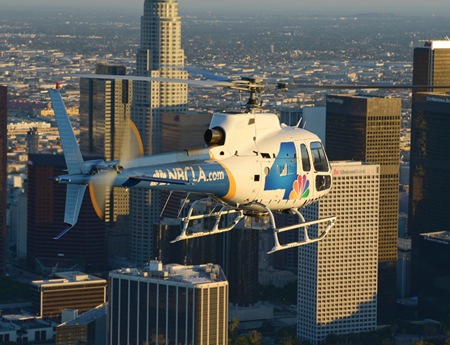Do Helicopter Sharing Agreements Fly in the Face of Redundancy?

As soon as Portland stations KGW and KPTV heard about a school shooting Oct. 1, they immediately deployed their shared helicopter to the site in Roseburg, Ore.
Within an hour and a half—well before their crews could complete the three-hour drive south to the rural town—the NBC and Fox affiliates from Portland (DMA No. 23) had live aerial footage. While the Eugene (DMA No. 120) and Medford (DMA No. 140) crews were on the ground, where access was closed down and blocked off, the KGW/KPTV chopper was capturing video of fire teams and dogs searching cars and police marking locations with bullet shells.
“It gave us a wide view of chaos unfolding, and a view of the college itself and its surroundings and what the physical landscape looked like,” says Rick Jacobs, KGW news director, noting his station had the only Portland news chopper in the air right after the shootings. “It was our first live look at what was going on down there. It was invaluable.”
There are countless examples of the importance of having a helicopter when covering breaking news; that is not up for debate. What is debatable is the necessity of a station having its own chopper.
“They’re expensive, but worth it for breaking news,” says Frank Whittaker, WMAQ news director, whose Chicago station has two helicopters.
After the financial crash, many stations could no longer afford to pay for their own helicopter and entered into sharing agreements with other stations in their markets. It was a simple trade-off: Pay half the price, but share video with competitors.
“I miss the exclusivity of when we owned a helicopter and [were] able to have stories and perspectives that nobody else has,” Jacobs says. “But the sharing agreement works well. We launch when there’s breaking news and ask questions later.”
The smarter way to stay on top of broadcasting and cable industry. Sign up below
After a few years, once the economy had begun to improve (and in some cases, patience waned), some larger-market stations including NBC’s O&Os in New York, Los Angeles, Philadelphia and Chicago ended sharing arrangements and began acquiring their own choppers again.
For instance, after shelving it for eight years, Scripps-owned WCPO put its Chopper 9 helicopter back in the air in early 2014; it is still the only chopper in the Cincinnati market (DMA No. 36).
Todd Mokhtari, VP of news at NBC’s L.A. O&O KNBC, says that all stations went through a downturn that spurred lots of sharing. “What it created in some newsrooms was a sense of complacency that made it OK to have those same stories,” he says. “It’s better to have independent news organizations make those decisions. That serves the viewers the best.”
KNBC, which ended its share agreement with the Fox L.A. station and got its own helicopter in 2012 and a second one about a year ago, is the rare station that has two choppers and will fly both at the same time. Part of that is because L.A. is so vast, as the second chopper is based in Orange County. But another crucial reason is flexibility.
In April, KNBC’s was the only helicopter following a car chase in San Bernardino, so it was also the only station to capture the police apprehending the suspect and beating him. The chopper footage was the focal point in an excessive force investigation, and three officers were charged in September. “If we hadn’t had that second chopper, no one would have covered it,” Mokhtari says.
WMAQ, the NBC O&O in Chicago, ended its share agreement with Fox in 2013 and returned to having its own chopper. “If you want to be first in breaking news, it’s tough to do that if you’re sharing a picture with the competition,” says Whittaker, the news director.
WMAQ certainly won breaking news on Sept. 29, when it was the only station to have ongoing aerial video of a car chase for nearly half an hour. The chopper followed the car, carrying a suspect wanted for a double murder, ripping through the streets of the city’s West Side during rush hour. WMAQ even preempted its 5:30 nightly news.
“It was important to stay on the air. People were in danger,” Whittaker says. “That’s why you have [your own] helicopters, for breaking news.”
Many stations, however, have not returned to operating their own chopper and don’t expect to.
KUSA, the Tegna-owned NBC affiliate in Denver, has been part of a chopper share with the ABC, CBS and Fox affiliates since 2010. Mark Cornetta, KUSA president and general manager, says they questioned the efficiency of paying for their own helicopter when the market’s other stations were covering the same thing more than 90% of the time. “At some point it became clear to me and others that we might be better off pooling resources, using savings for other things like reinvesting in news operations,” he says.
The four stations share footage but rotate control of the chopper each quarter. “It would be difficult to see this in the future not working,” Cornetta says.
Ken Pyatt, president of Sky Helicopters, which has five contracts for news helicopters and is adding two more, says he hasn’t really seen sharing agreements go away. “The people who started in 2008 are still doing it,” he says. “They got used to cutting the cost in half. There’s no legitimate reason to undo that.”
Still, even if advantages like exclusivity and flexibility are not worth the price to many stations, a few more going their own way could perhaps cause a ripple effect.
“I don’t see a day when we’d be doing this independently,” Cornetta says. “That’s not to say if everyone decided tomorrow to get out, we wouldn’t still be in the air.”
